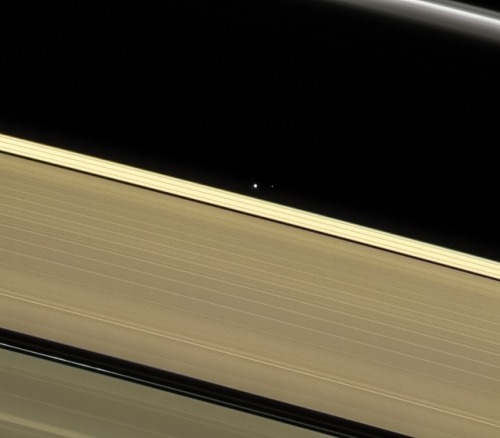
Amateur astronomer, owns a telescope. This is a side blog to satiate my science-y cravings! I haven't yet mustered the courage to put up my personal astro-stuff here. Main blog : @an-abyss-called-life
212 posts
Latest Posts by starry-shores - Page 7
From the invention of wireless to Radio Broadcast to Space

The word radio was coined in 1907 after a decade of furious activity to discover the mechanism for wireless transmission. A decade earlier, French physicist Édouard Branly coined the term radioconductor to describe a means of wireless transmission. He based his term on the verb radiate which ultimately came from the Latin word radius meaning the spoke of a wheel, a ray or beam of light. The word radio was first used by itself in a 1907 article by Lee De Forest. It was used five years later by the Navy to distinguish it from other wireless technologies and entered common usage in the next decade. Radio technology advanced so quickly that a little over 50 years later on November 16, 1974, scientists broadcast the first interstellar radio message out to the stars, a program that later became known as METI, the Message to Extra-terrestrial Intelligence. To date, only 9 messages have been transmitted by a variety of organizations:
{The Morse Message (1962)}
Arecibo message (1974)
Cosmic Call 1 (1999)
Teen Age Message (2001)
Cosmic Call 2 (2003)
Across the Universe (2008)
A Message From Earth (2008)
Hello From Earth (2009)
RuBisCo Stars (2009)
Wow! Reply (2012)
The first radio message, known as the Morse Message, does not technically belong on this list as the Russians directed the message to Venus, and thus the primary mission was not Interstellar. The message targets vary in distance from the very short (the majority of targets are under 100 light years away) to the very far, including the Arecibo Message, which targets the M13 globular cluster 24,000 light years away.

While there have been some dissenting voices who argue that ‘revealing’ our location to enemy or hostile alien civilizations is ill-advised at best, most scientific consensus agrees that due to the physical restrictions on speed and travel (as currently understood) we are in no danger of imminent attack. While the Arecibo Message won’t reach its target for another 25,000 years or so, the first of the other messages should arrive by 2029. Other scientist point out that our current terrestrial radio and television broadcasts represent their own METI signal and thus we have no need to fund additional broad- or narrow-cast messages.
Image of the Arecibo Radio Telescope courtesy Marius Strom under a Creative Commons 3.0 share alike license.
Image of the Arecibo Message of 1679 bits in the public domain.

Demonstration of the 1974 Arecibo message. The radio message, consisting of seven different parts showcasing human technological knowledge, was sent from Earth to star cluster M13, 25,000 light years away.
(In the actual message the different parts aren’t colored.)
Gamma-ray Bursts: Black Hole Birth Announcements
Gamma-ray bursts are the brightest, most violent explosions in the universe, but they can be surprisingly tricky to detect. Our eyes can’t see them because they are tuned to just a limited portion of the types of light that exist, but thanks to technology, we can even see the highest-energy form of light in the cosmos — gamma rays.
So how did we discover gamma-ray bursts?
Accidentally!

We didn’t actually develop gamma-ray detectors to peer at the universe — we were keeping an eye on our neighbors! During the Cold War, the United States and the former Soviet Union both signed the Nuclear Test Ban Treaty of 1963 that stated neither nation would test nuclear weapons in space. Just one week later, the US launched the first Vela satellite to ensure the treaty wasn’t being violated. What they saw instead were gamma-ray events happening out in the cosmos!

Things Going Bump in the Cosmos
Each of these gamma-ray events, dubbed “gamma-ray bursts” or GRBs, lasted such a short time that information was very difficult to gather. For decades their origins, locations and causes remained a cosmic mystery, but in recent years we’ve been able to figure out a lot about GRBs. They come in two flavors: short-duration (less than two seconds) and long-duration (two seconds or more). Short and long bursts seem to be caused by different cosmic events, but the end result is thought to be the birth of a black hole.

Short GRBs are created by binary neutron star mergers. Neutron stars are the superdense leftover cores of really massive stars that have gone supernova. When two of them crash together (long after they’ve gone supernova) the collision releases a spectacular amount of energy before producing a black hole. Astronomers suspect something similar may occur in a merger between a neutron star and an already-existing black hole.

Long GRBs account for most of the bursts we see and can be created when an extremely massive star goes supernova and launches jets of material at nearly the speed of light (though not every supernova will produce a GRB). They can last just a few seconds or several minutes, though some extremely long GRBs have been known to last for hours!

A Gamma-Ray Burst a Day Sends Waves of Light Our Way!
Our Fermi Gamma-ray Space Telescope detects a GRB nearly every day, but there are actually many more happening — we just can’t see them! In a GRB, the gamma rays are shot out in a narrow beam. We have to be lined up just right in order to detect them, because not all bursts are beamed toward us — when we see one it’s because we’re looking right down the barrel of the gamma-ray gun. Scientists estimate that there are at least 50 times more GRBs happening each day than we detect!

So what’s left after a GRB — just a solitary black hole? Since GRBs usually last only a matter of seconds, it’s very difficult to study them in-depth. Fortunately, each one leaves an afterglow that can last for hours or even years in extreme cases. Afterglows are created when the GRB jets run into material surrounding the star. Because that material slows the jets down, we see lower-energy light, like X-rays and radio waves, that can take a while to fade. Afterglows are so important in helping us understand more about GRBs that our Neil Gehrels Swift Observatory was specifically designed to study them!

Last fall, we had the opportunity to learn even more from a gamma-ray burst than usual! From 130 million light-years away, Fermi witnessed a pair of neutron stars collide, creating a spectacular short GRB. What made this burst extra special was the fact that ground-based gravitational wave detectors LIGO and Virgo caught the same event, linking light and gravitational waves to the same source for the first time ever!

For over 10 years now, Fermi has been exploring the gamma-ray universe. Thanks to Fermi, scientists are learning more about the fundamental physics of the cosmos, from dark matter to the nature of space-time and beyond. Discover more about how we’ll be celebrating Fermi’s achievements all year!
Make sure to follow us on Tumblr for your regular dose of space: http://nasa.tumblr.com

Cover design for an Italian reprint of Isaac Asimov’s “Foundation Trilogy” by Gabriel Björk Stiernström.
Asimov invented the three laws of robotics and spent most of his robot books pulling them apart and exploring why they wouldn’t work but why they couldn’t really be improved, either.
Most robot revolution stories assume the danger is when robots stop obeying us and start thinking for themselves.
Asimov’s stories suggest that the real danger is robots doing exactly what we tell them to.
I think that’s both more realistic and actually scarier.
Okay, the title of The Atlantic’s article might be a little click-bait-y. But the discovery is truly remarkable. A new bone has been analyzed from the already-famous cave in Russia, and it belonged to, per DNA analysis, the daughter of a Neanderthal mother and a Denisovan father.
These Are The Oldest Footprints On Earth

Found on a prehistoric sea floor, the oldest footprints ever found were left between 551 million and 541 million years ago during the Ediacaran period. That is hundreds of millions of years before the dinosaurs.
The trackways tell scientists it was left by a bilaterian animal — that is, a creature with bilateral symmetry that has a head at one end, a back end at the other, and a symmetrical right and left side. Its paired appendages, scientists did not call them legs, were used to raise the animal off the sea floor as it moved.
TOP 10 PREHISTORIC OCEAN PREDATORS

10. ANOMALOCARIS (~ 525 Ma) This one metre long invertebrate surely deserves to be included on the list, being one of the first complex oceanic predators to ever have existed. Anomalocaris stalked the Cambrian oceans, viewing the world with a deadly new evolutionary innovation - eyes. Complex eyes allowed this creature to storm its way to the top of the food chain, and with powerful appendages covered in spines it had no trouble devouring prey with tough carapaces. Whilst Anomalocaris is dwarfed by the other contenders on this list, it was still over 10 times larger than any other animal of its time.

9. KRONOSAURUS (125-99 Ma) Kronosaurus, a Cretaceous mosasaur, is named after the Greek titan, Cronus. Its name is well deserved as this ancient beast was a remarkably powerful being. Kronosaurus could reach up to 10 metres long and had a mouth full of sharp, conical teeth. Unlike most other mosasaurs its tail was relatively short, however, evidence shows that Kronosaurus has immensely powerful fins and a pectoral girdle making it an impressive swimmer and hunter.

8. HELICOPRION (290-250 Ma) Helicoprion has astounded scientists since its discovery over 100 years ago. It is iconic for its bizarre spiral of teeth, there are still debates on where exactly these teeth where on the shark with proposals stating they were inside the mouth, on the tip of the tail, the dorsal fin or hanging under the jaw. The most commonly accepted location of the teeth is inside the lower jaw enabling Helicoprion to cleanly slice its prey into pieces.

7. XIPHACTINUS (~110-70 Ma) Xiphactinus was an extraordinary fish that lived during the Cretaceous. It was an esteemed predator that could reach an incredible 6 metres in length and specimens are renowned for their stunning preservation. One such example was 4 metres long and found with another exceptionally well preserved fish just short of 2 metres inside it implying that this particular Xiphactinus individual died shortly after its last feast. Xiphactinus had immensely sharp, slim teeth and an unmistakable underbite which was a possible aid when snaring creatures from below.

6. TYLOSAURUS (86-75 Ma) Tylosaurus is considered a mosasaur and was a vivacious predator all be it smaller than its relative Mosasaurus. Tylosaurus could reach up to 15 metres in length and was one of the apex predators of its day. Fossilised stomach contents of Tylosaurus contain fish, sharks, turtles and other marine reptiles. Despite having an impressive set of teeth, the frontal areas of the jaws exhibit a large reduction in tooth size as well as a more heavily reinforced snout in comparison to other mosasaurs suggesting that Tylosaurus may have rammed into victims with immense force damaging prey internally.

5. MOSASAURUS (70-66 Ma) The mosasaurs ruled the Cretaceous oceans and Mosasaurus was no exception. It could reach up to 17 metres long, longer than most other mosasaurs. Mosasaurus had a strong jaw packed with numerous conical teeth, bite marks of which have been found in huge prehistoric turtles and ammonites suggesting that Mosasaurus was a formidable hunter capable of catching large prey. Mosasaurus was a profound swimmer with strong paddle-like limbs and a huge tail capable of rapidly accelerating the animal when required.

4. DUNKLEOSTEUS (382-358 Ma) Dunkleosteus terrorised the oceans around 370 million years ago and was part of a dynasty known as the placoderm fish (meaning armoured). Dunkleosteus could reach a whopping 6-10 metres in length and probably weighed over a ton. The skull was made up of huge, solid bony plates giving unrivalled protection allowing them to dominate the oceans. Placoderm fish were some of the first organisms to have a mobile jaw, as can be seen in Dunkleosteus’ impressive shearing plates which were used to slice cleanly through prey. Despite an revolutionary jaw, Dunkleosteus could not chew and several fossilised regurgitated remains of its meals have been found that the giant fish simply could not stomach.

3. DAKOSAURUS (157-137 Ma) Dakosaurus was the largest of a group of marine reptiles that were distant relatives of crocodiles. Dakosaurus could reach up to 5 metres long and had a streamlined body with large paddle-like fins and a long muscular tail implying that is was a very efficient swimmer. The diet of Dakosaurus consisted mostly of fish. The teeth of Dakosaurus are lateromedially compressed and serrated which is a similar morphology to modern killer whales indicating that Dakosaurus was an apex predator of the Jurassic oceans. Skull fenestrae provides evidence that Dakosaurus had very large adductor muscles (which are responsible for the jaw closing) and so it was certainly capable of a forceful bite.

2. LIOPLEURODON (160-155 Ma) Liopleurodon stormed the Jurassic oceans, its huge 7 metre long frame effortlessly cruised through the water. The skull itself could reach a massive 1.5 metres long with a jaw that was packed with teeth up to 10cm long and was capable of an immense bone-crushing force. Liopleurodon was a remarkable hunter with the ability to swim with its nostrils open and so could use its powerful sense of smell to track prey from afar, much like sharks do. Liopleurodon most likely had good camouflage such as a lighter underside and a darker topside so it would blend in with the water to prey above and below.

1. MEGALODON (~16-2.6 Ma) Megalodon rightfully deserves the top position of the greatest prehistoric ocean predators, ruling the seas for an incredible 14 million years. Megalodon has been estimated to reach up to 18 metres in length and weighing over 40 tonnes. Megalodon is known for its huge 6 inch teeth which were serrated on both sides for an efficient slicing action. Fossils of Megalodon’s prey have also been found, the shark appeared to have adapted its hunting tactics for different sized prey; for smaller prey they would just use their bone crushing bite to pulverise internal organs, but for larger prey they would bite or rip flippers off of creatures to immobilise them and then go in for the kill. The exact bite force of Megalodon has been estimated at around 110,000 N which was more than enough to shatter even the most robust bones. The hunting methods of Megalodon will unfortunately remain a mystery but it was been hypothesised that they swam at great depths and used short bursts of speed to swim up and tear into their preys vulnerable underbelly. Sharks have existed for over 420 million years and still continue to be some of the most successful predators alive, Megalodon is a perfect example of how deadly they can be.
QUETZALCOATLUS

Quetzalcoatlus goes down in history as the largest flying organism of all time, with a wingspan of 12 metres, which is larger than some planes. Quetzalcoatlus was the undisputed king of the Late cretaceous skies, so it seems fitting that its name is derived from an Aztec god, Quetzalcoatl. Although its wingspan is impressive, Quetzalcoatlus also had a huge 2.5 metre long skull, that is the average height of an Asian elephant! To get such a huge animal in the air, a complex system of air sacs was needed inside the bones, this meant that Quetzalcoatlus probably weighed no more than 250kg. Quetzalcoatlus, along with many pterosaurs, was originally thought to spend most of its time gliding over the oceans, skimming fish out from the surface of the water with their elongated beaks. However, due to the skull and beak morphology and the presence of fossils far inland it has become more widely accepted that Quetzalcoatlus stalked prey far below on the land. The fore and hind limb morphology of Quetzalcoatlus also suggests that they were competent walkers on the land, they would have stood up to 3 metres tall.

The feeding habits of Quetzalcoatlus still remain something of a mystery. It was originally thought to be more of a scavenger, but the blunt beak was unsuited to stripping and picking flesh of a bony creature. It is more likely that Quetzalcoatlus hunted like modern-day storks, stalking the land from the skies above for smaller animals and then swooping down to eat them whole.
WHY THE TRIASSIC????
What the FUCK is so WEIRD about the Triassic?
Well I will TELL YOU!
Okay so first of all, the Triassic is SUPER DUPER OLD. In the grand scheme of the Earth, sure, it happened relatively recently, but working on the scale of the entire geologic time span of the Earth’s existence is not exactly fair:

I mean, animals that we can recognize today didn’t show up until that line in the Phanerozoic (Hadean is the oldest stuff), so like, it’s smack dab in the middle of THAT
Look, basically, here’s what happened:
- The earth Formed. Life Appeared. Chaos reigned (4,600 million years ago until 4,000 million years ago)
- Life began to become more complex. Some life began to stick its blueprints inside of pockets so they’d be safer. They then swallowed other life forms that were better at getting energy, but kept them around like a buddy inside of them. Some of these guys could make a shitton of oxygen. This made the earth cool and a lot of shit die out super duper quickly. Extinction rate unknown. (4,000 million years ago until 2,500 million years ago)
- Climate change and fluctuating oceans allow life to start to group up together into SuperLife aka Multicellular Things. These multicellular things got more and more complicated. Some became animals and started moving around a lot. Some plants went on land. Some things were super weird looking and mysterious. LOTS of experimentation by life. Things start to change and a lot of these early experiments go extinct. Extinction rate unknown. (2,500 million years ago until 541 million years ago)
- Animals can suddenly burrow underground and go absolutely apeshit and diversify faster than you can say “wait a second whAT THE FUCK IS THAT”. Ice Age causes Death, 85% of species die out. (541-444 million years ago)
- Fish suddenly have a chance to be weird too and some of them decide, what the heck, let’s crawl onto land. Why not, right? Some other animals decide to join them. Plants make everything super cold, 75% of all species die out. (444-359 mya)
- Land-vertebrates start to diversify. They try out a lot of new things, but there aren’t a lot of them yet. So there’s still a lot of experimentation in body plans. Mammal-relatives are actually some of the most diverse ones. Reptiles are fairly rare. A GIANT MASS EXTINCTION CAUSED BY A GIANT LAVA FIELD EXPLODING KILLS ~95% OF LIFE ON EARTH. (359-252 mya)
- NEW animals get to try to diversify and do lots of crazy shit in the wake of SO MANY JOBS IN THE ENVIRONMENT GETTING CLEARED OUT. Reptiles diversify so fast you don’t know what the heck is happening. Other animals also take this opportunity to do new and weird shit. VOLCANOS EXPLODE, KILL ~80% OF LIFE (252-201 mya)
- Dinosaurs finally get to do fun things now that other reptiles are no longer being weird. Modern life starts to show up. (201 mya-today).

BASICALLY:
- Land Animals had only just started to diversify and try out new funky things with their bodies in order to cope with the challenges of terrestrial life
- Then a giant mass extinction killed everything. Mass exinctions are bad news for a lot of shit that’s specialized for the environment that’s been destroyed, BUT it allows things that make it through to have a chance to try out new shit to fill all those empty jobs in the environment
- So, generalist reptiles, who hadn’t had a chance to do jack diddly squat before, now suddenly had the whole planet to play with. And the other animals around them, from mammal-cousins to amphibians to fish to insects to other invertebrates, also got to try out some new stuff in this new world
- AND THEN ANOTHER MASS EXTINCTION HAPPENED RIGHT AFTER THAT RESET THE CLOCK AGAIN
This means that the TRIASSIC has some of THE MOST UNIQUE ANIMALS TO HAVE EVER EVOLVED IN EARTH’S HISTORY. Experiments were tried, rapidly, and MANY were lost RIGHT AWAY. It’s not like the life that evolved after that, which was honestly similar to what we see today - or those that evolved after the end-Cretaceous extinction, which was even more like today. These were weirdos that appeared and were wiped out before they could continue on to today
And, because this was a rapid evolutionary period, we see the starts of many of today’s modern groups of animals, and they’re super weird, too!
Honestly, the only weirder period in Earth’s history is the Cambrian Explosion, when animals first started doing anything notable at all

On top of THAT, the ENTIRE EARTH was ONE GIANT SUPERCONTINENT called Pangea! Everyone could go everywhere! There were no terrestrial barriers to movement! So many creatures spread all over the globe. It was a HOTSPOT of biodiversity and a major turning point in Earth’s History
But, because the dinosaurs that evolved in the Triassic were kind of Meh, it doesn’t get enough press!!!!!!!!!!!!!
So, we’re going to cover the Weird and Wonderful animals of the Triassic - we have a carefully curated list of Weirdos ready to take Tumblr by storm, and we hope you’ll enjoy learning about these amazing animals right along with us! You’ll have to wait till tomorrow to see them, though - don’t want to give away the surprises!
GET! PUMPED!

IT’S TRIASSIC TIME!
cosiscience
Walking dinosaur, Columbus Interactive Science Museum


“We don’t just have a skeleton,” said one of the nodosaur researchers involved. “We have a dinosaur as it would have been.”
Known as a nodosaur, this 110 million-year-old, armored plant-eater is the best preserved fossil of its kind ever found.
Source | Source
Isn’t it kind of bananas that for most of human history we’ve been completely oblivious to how utterly environmentally tumultuous the planet has historically been? Before the advent of paleontology, conventional wisdom posited that the earth has more or less looked the same for as long as its been around, but soon enough naturalists like Georges Cuvier came along and said, “well it actually turns out that most of the organisms that have ever existed are actually no longer with us,” thereby introducing the entire concept of extinction to the human race?? Do you realize how coconuts that must have sounded back then?
Not only that, but the more we delved into paleontology the more it became apparent that the Earth has spent so much of its existence (about a billion years) being completely unsuitable and even hostile to life as we know it. A significant stretch of the cosmic timeline classifies our planet as being an oxygen-poor wasteland constantly pounded by asteroids and brimming with active super volcanoes. Even after life on Earth started to stretch out its stubby little amphibious legs we’ve had like five mass extinctions events almost completely fuck it all up (including one known as the Permian extinction which killed off no less than 70% of the planet’s land-based life and 96% of its sea critters). Can you recognize how rare and unlikely it is that out of all the downright catastrophic times any of us could have existed as unfortunate little trilobites or dimetrodons we actually get to exist as humans beings who can learn about this stuff with the help of a scientific discipline that effectively allows us to peer back into the reaches of the past?? Anyway, here’s wonderwall
Helicoprion: What if, like, teeth,
Mesosaurus: Yeah?
Helicoprion: but WHEEL
Mesosaurus: No don't -
Helicoprion:

(Image by ДиБгд)

The Most Hardcore Period in Earth’s History, or the Permian, was preceded by a complete ecosystem collapse, and featured three different major mass extinction events - including the largest in earth’s history, the Great Dying, which lead to nearly all life on earth dying out.
During the Permian, all the land on Earth was in one supercontinent, called Pangea; and all the water was in one ocean, called Panthalassa. This meant that life intermingled and expanded all over the world, more so than it was able to in other periods (besides the Triassic, which also featured a single continent and a single ocean).

Pangea, and the Permian, was characterized by extremes. The beginning of the Period featured the end of the Karoo Ice Age - the poles were filled with ice caps, the center of the continent was dry, and temperature extremes were found throughout the land and ocean. The end featured multiple mass extinctions and a rapid warming of the continent, reaching the extreme heat of the Triassic period.

By @franzanth
The Carboniferous Rainforest Collapse was primarily caused by an intensification of that ice age - leading to the start of the Permian featuring dry, harsh, extreme climates. This time period featured the rapid diversification and specialization of some of the earliest animals adapted for a dry existence - prior to now, life almost entirely existed in the oceans, or in the forested and swampy world of the Carboniferous. This was the first truly dry time for (at least some) life.

By @alphynix
Olson’s Extinction marked a change from that initial habitat in the Cisuralian epoch to the next, the Guadalupian. As the world began to rapidly warm after the Karoo Ice Age ended, this lead to a major extinction of plants and vertebrates especially. The vertebrates would not fully recover before the Triassic; however, it did lead to many new forms, especially among synapsids, appearing in the new vacant environmental roles.

(By @paleoart)
The Capitanian Extinction was caused by the explosion of a moderately sized laval flow system, the Emeishan Traps, which lead to immediate global cooling followed by rapid global warming. This greatly affected ocean chemistry, making it far more acidic than previously. Many reef animals were killed by this extinction, in addition to brachiopods; many vertebrates were also affected.

(By @paleoart)
So the Permian was a hard, broken world when the Siberian Traps - one of the largest lava flows in Earth’s History, and one of the largest volcanic events known - exploded, leading to even more dramatic climate change and extremely rapid global warming. This lead to acidification of the ocean’s and a dramatic drop in ocean oxygen. Almost every group of organisms was dramatically affected, and this extinction was the largest known in Earth’s History, with between 85-96% of life on Earth dying out (and some researchers thinking it may have even been higher), leading to this extinction being dubbed The Great Dying. Many groups utterly disappeared, despite having been features of the entire Paleozoic Eon (the eon that the Permian was at the end of) - trilobites, eurypterids, “spiny sharks”, tabulate and rugose corals, and blastoids complete disappeared, as did many other groups. Brachiopods, Gastropods, Ammonites, Radiolarians, Foraminiferans, Crinoids, and most Parareptiles also went extinct, as did many synapsids and amphibians. It was an utter catastrophe.

(By @paleoart)
The Permian was a time of extensive hardship, dramatic changes, and extinction event after extinction event. Life was truly on the brink - just as it was beginning to settle into terrestrial existence. So new animals, from insects to amniotes to conifers, spent their school years in a prehistoric hunger games - and only a few species managed to reach the weirdness kiln of the Triassic.
Welcome to the Permian.
The Most Hardcore Period of Earth’s History.
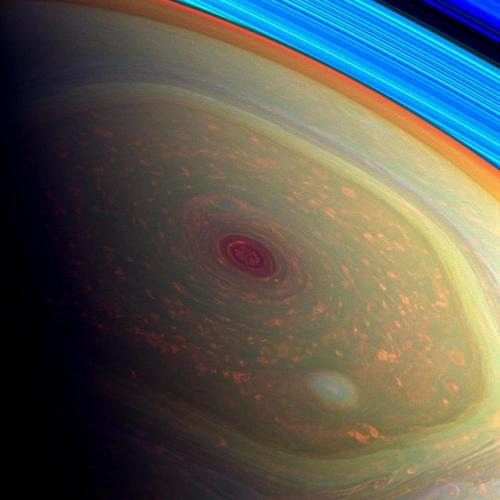
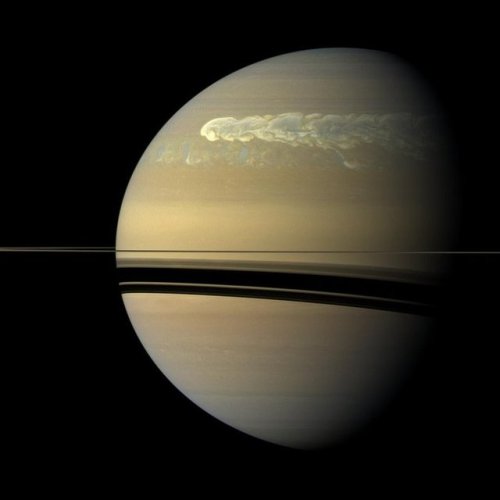
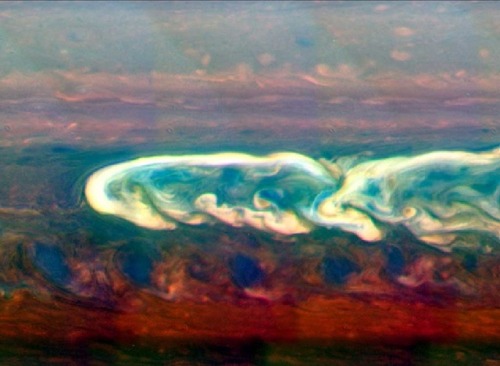



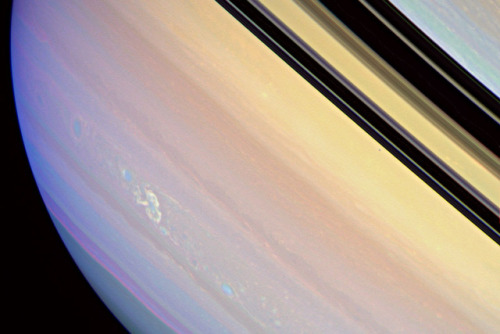

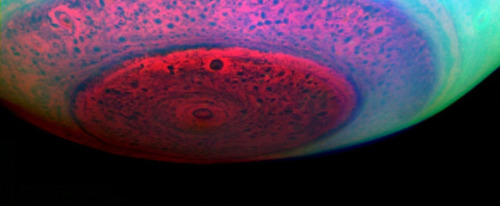
Saturn’s atmosphere exhibits a banded pattern similar to Jupiter’s, but Saturn’s bands are much fainter and are much wider near the equator. The nomenclature used to describe these bands is the same as on Jupiter. Saturn’s finer cloud patterns were not observed until the flybys of the Voyager spacecraft during the 1980s. Since then, Earth-based telescopy has improved to the point where regular observations can be made. The composition of the clouds varies with depth and increasing pressure.
The winds on Saturn are the second fastest among the Solar System’s planets, after Neptune’s. Voyager data indicate peak easterly winds of 500 m/s (1,800 km/h).
Thermography has shown that Saturn’s south pole has a warm polar vortex, the only known example of such a phenomenon in the Solar System. Whereas temperatures on Saturn are normally −185 °C, temperatures on the vortex often reach as high as −122 °C, suspected to be the warmest spot on Saturn.
Credit: NASA/JPL-Caltech/Space Science Institute and Kevin M. Gill
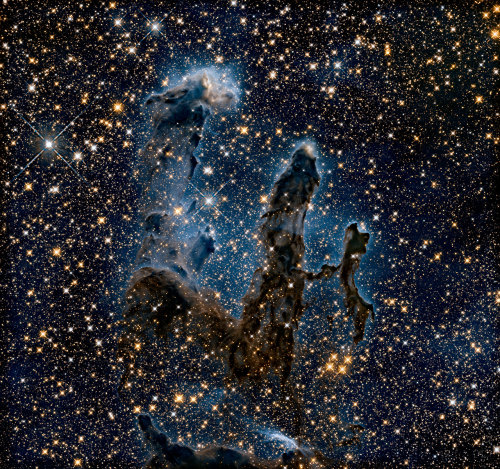
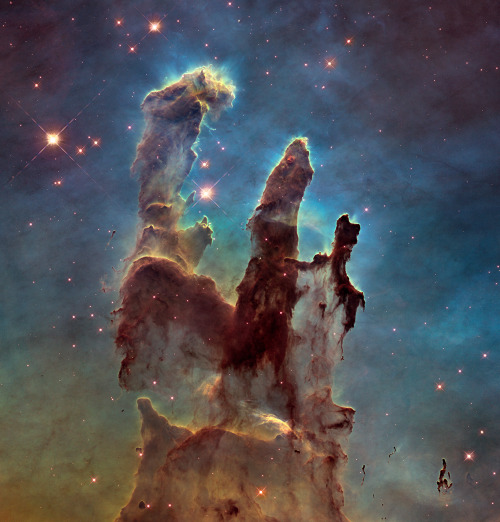
Sometimes… there’s more than meets the eye. 👀 You’re looking at two very different takes on an iconic image.
Human eyes can see only a small portion of the range of radiation given off by the objects around us. We call this wide array of radiation the electromagnetic spectrum, and the part we can see visible light.
In the first image, researchers revisited one of Hubble Space Telescope’s most popular sights: the Eagle Nebula’s Pillars of Creation. Here, the pillars are seen in infrared light, which pierces through obscuring dust and gas and unveil a more unfamiliar — but just as amazing — view of the pillars. The entire frame is peppered with bright stars and baby stars are revealed being formed within the pillars themselves. The image on the bottom is the pillars in visible light.
Image Credit: NASA, ESA/Hubble and the Hubble Heritage Team
Make sure to follow us on Tumblr for your regular dose of space: http://nasa.tumblr.com.














